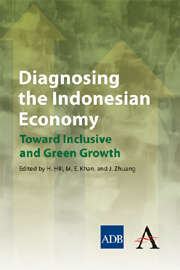Book contents
- Frontmatter
- Foreword
- Preface
- Author Profiles
- Abbreviations and Acronyms
- Contents
- 1 Introduction
- 2 Development Policies and Performance
- 3 Critical Constraints to Growth
- 4 Critical Constraints to Reducing Poverty and Inequality
- 5 Macroeconomic Management
- 6 Industrialization: Patterns, Issues, and Constraints
- 7 Infrastructure Development: Challenges and the Way Forward
- 8 Human Capital and Economic Development
- 9 Economic Growth, Employment Creation, and Poverty Alleviation
- 10 Poverty Reduction: The Track Record and Way Forward
- 11 Decentralization
- 12 Making Indonesia's Growth Green and Resilient
- Index
1 - Introduction
Published online by Cambridge University Press: 05 May 2012
- Frontmatter
- Foreword
- Preface
- Author Profiles
- Abbreviations and Acronyms
- Contents
- 1 Introduction
- 2 Development Policies and Performance
- 3 Critical Constraints to Growth
- 4 Critical Constraints to Reducing Poverty and Inequality
- 5 Macroeconomic Management
- 6 Industrialization: Patterns, Issues, and Constraints
- 7 Infrastructure Development: Challenges and the Way Forward
- 8 Human Capital and Economic Development
- 9 Economic Growth, Employment Creation, and Poverty Alleviation
- 10 Poverty Reduction: The Track Record and Way Forward
- 11 Decentralization
- 12 Making Indonesia's Growth Green and Resilient
- Index
Summary
Objectives
The Indonesian economy has performed well in recent years. It recovered from the 1997 Asian financial crisis and grew at an average of 5.2% during 2001–2008, which compared favorably with other major Southeast Asian economies. Despite the global economic crisis, the economy posted a growth rate of 4.5% in 2009—one of the highest in Southeast Asia. Nevertheless, the challenges faced by the economy remain formidable. The rate of economic growth in recent years has not been at par with the average the country achieved between 1967 and 1997. The pace of poverty reduction has slowed, and the poverty incidence, at 14.2% in 2009, was only 3.5 percentage points lower than that in 1996. Income and non-income disparities across the country's regions and across the urban–rural divide remain wide. In addition, the expected fall in commodity prices, continued uncertainty about the recovery of the global economy, and tightening of domestic credit further threaten investment and private consumption and in turn hamper the pace of economic growth and poverty reduction.
The Indonesian government is committed to sustaining and improving the growth it has attained in recent years. This commitment is embodied in the current medium-term development plan and will be carried forward in succeeding ones. The creation of a prosperous Indonesia through economic and social development is one of the current plan's three major agenda items.
- Type
- Chapter
- Information
- Diagnosing the Indonesian EconomyToward Inclusive and Green Growth, pp. 1 - 12Publisher: Anthem PressPrint publication year: 2012
- 1
- Cited by



